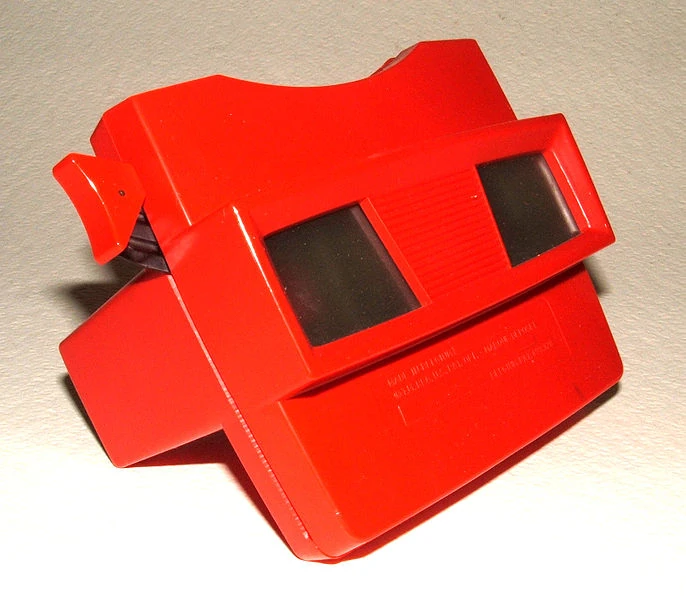Hello ladies and gents this si the viking telling you that today we are talking about

VIEW-MASTER

View-Master is the trademark name of a line of special-format stereoscopes and corresponding View-Master "reels", which are thin cardboard disks containing seven stereoscopic 3-D pairs of small transparent color photographs on film. It was manufactured and sold by Sawyer's.
The View-Master system was introduced in 1939, four years after the advent of Kodachrome color film made the use of small high-quality photographic color images practical. Tourist attraction and travel views predominated in View-Master's early lists of available reels, most of which were meant to be interesting to users of all ages. Most current View-Master reels are intended for children.
1919–56: early photo services
Edwin Eugene Mayer worked as a pharmacist at Owl Drug store in downtown Portland, Oregon, after serving in the U.S. Army in World War I. He built up a photo-finishing business there, and bought into Sawyer's Photo Finishing Service in 1919 with the help of his father August Mayer, his fiancée Eva McAnulty, and her sister Vi McAnulty.
Edwin described how he started the business in a letter dated April 1, 1954: "Suffice to say that in 1919, what little it was, was purchased with borrowed ($3,500) money from Dad, aided by about $1,600 in insurance money Eva got when her father died and which was left in permanently, and $1,600 borrowed from Vi and repaid, along with Dad's notes, within a few years."
As the business grew, Ed Mayer incorporated in about 1926, taking on partners Harold and Beulth F. Graves, Thomas and Pauline Meyer, and Augusta and Raymond F. Kelly, renaming the business Sawyer Service, Inc. The company relocated to a large two-story building at 181 Ella St., near Morrison Street in Portland, Oregon.
The company was producing photographic postcards and album sets as souvenirs by 1926, when Harold Graves joined Sawyer's. Graves handled marketing for the products while Mayer ran the business. Later, photographic greeting cards were added to the Sawyer's product line, marketed to major department stores. Sawyer's was the nation's largest producer of scenic postcards in the 1920s and the future View-Master viewer eventually became an extension of the two-dimensional cards.
The company took the first steps towards developing the View-Master after Edwin Mayer and Graves met with William Gruber, an organ maker of German origin trained by Welte & Sons and an avid photographer living in Portland. Mayer and Gruber had both developed devices for viewing stereo images, but Gruber had made up a stereo imaging rig out of two Kodak Bantam Specials mounted together on a tripod. He designed a machine that mounted the tiny pieces of Kodachrome color transparency film into reels made from heavy paper stock. A special viewer was also designed and produced. He had the idea of updating the old-fashioned stereoscope by using the new Kodachrome 16-mm color film, which recently had become available.
2015-present: Virtual reality
In February 2015, Mattel announced a collaboration with Google to produce a new version of View-Master called the View-Master Virtual Realty Viewer, based on virtual reality using smartphones. The new View-Master is an implementation of the Google Cardboard VR platform, and is accompanied by a mobile app that was built using its SDK. Content is displayed on a smartphone screen; the phone itself is inserted into the back of the unit. Instead of being inserted directly into the View-Master, reels are scanned using an augmented reality interface which enables access to content from the reel, such as 360-degree panoramas, 3D models, and minigames.
Greenbot considered the View-Master to be the best low-cost Cardboard viewer, citing its build quality and comfort over models actually constructed from cardboard, but noting that the latch mechanism for securing the phone inside wasn't tight enough, and that there was no headphone jack access. It was felt that the View-Master VR was "the kind of thing you might grab as a gift for the kids, but if you're curious about VR on your phone, chances are you'll use it as much as they do."
In 2016, an updated iteration known as the DLX was released; it features improvements to its compatibility with smaller phones, a more secure latch for the phone compartment, and also adds focal adjustment and a headphone port.
In 2019, Mattel partnered with MGM to announce an upcoming feature film based on the View-Master. The project will be co-piloted by Robbie Brenner of Mattel's Films division and MGM's Cassidy Lange
Cumulative production and honor
There have been some 25 viewer models, thousands of titles, and 1.5 billion copies of reels. The basic design remained intact for reels and internal mechanisms, despite its long history and many changes in models and materials, ensuring that every reel will work in every model. View-Master is part of the National Toy Hall of Fame of the United States.
I hope you liked this post i had one did you?
Comments
Post a Comment